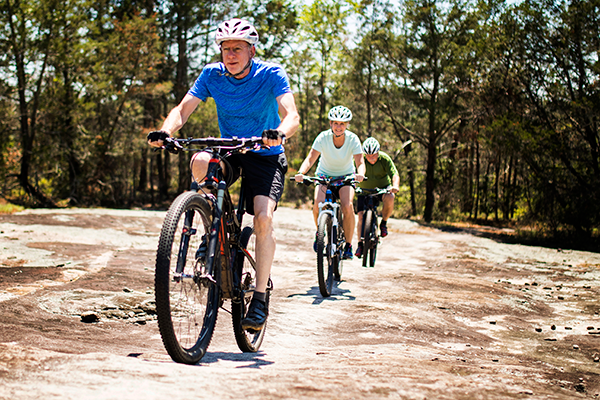HOME / BICYCLE NSW NEWS • COMMUNITY • SAFETY GUIDES
Riding in a group is an exciting experience and can lead to some amazing adventures! St George BUG has come up with some helpful hints to ensure everyone remains safe and has a fun time.

Equipment
- Your bicycle should be in good working order, with tyres pumped and chain oiled.
- Do not ride if your brakes are defective.
- You must wear a helmet – it’s the law.
- Take a full drink bottle of water and be sure to drink regularly.
- Wear suitable clothing – a brightly coloured top is advisable.
- Carry a spare tube which is the correct fit for your tyre, a pump and tyre levers.
- If the ride is in the early morning or evening, make sure you have front and rear lights.
- A mirror on your handlebar or wrist is an advantage.
- A bell is very necessary when riding on shared cycle paths.
- Use sunscreen when appropriate – you’ll probably be out in the sun for a few hours.
Riding Etiquette
- If you haven’t ridden with a group before, let the group know, so they don’t ride too close to you.
- Listen carefully to the ride leader’s instructions at the start of the ride.
- Watch for hand signals from riders in front of you, e.g. left and right hand turns, slowing or stopping, debris or potholes on the road. The ride leader will show you the signals.
- Pass on the signals to the riders behind you, or call them out if you are unable to do them.
- Call out “bollard” when approaching one as you might block it from the vision of riders behind you.
- Keep to the left when riding, so others can pass you if necessary.
- If you pass a rider or walker, call out “passing”.
- When riding on a road single file is preferred. If the sweep calls out “car back”, it means a car needs to pass, so make sure you keep to the left in single file.
- When approaching a roundabout, check behind to see if the road is clear, then take the middle of the lane to go into the roundabout so you don’t get nudged to the side if a car tries to pass.
- Always stop for red lights even if the riders ahead have gone through. They will wait for you.
- Don’t shout abuse at pedestrians, cyclists or motorists or use rude gestures.
- Remember that pedestrians have right of way on most shared paths.
- If the group has stopped to wait for you, don’t ride up to the front of the group, but join the back of the group.
Avoiding Accidents
- Always move yourself and your bike to the left edge of the path when you stop. Not only does this avoid riders colliding with you, it also stops others who use the path from getting annoyed.
- Don’t swerve in and out of the group.
- Bollards come in all shapes and sizes. Watch out for them on shared paths, slow down and call out to riders behind you to alert them.
- When riding up onto a footpath or across a gutter, always approach at a right angle. If you approach side-on, your tyre might not get over the lip and your bike will stop suddenly.
- Look out for potholes and tree roots and always be on the alert for changes in the path or road surface. Concentrate on the path ahead.
- Watch out for bushes, tree branches or vines that encroach on cycle paths.
- Occasionally there are off-leash dogs on paths. Slow down and be prepared to stop as they are often unpredictable and can cause you to fall over.
- Ring your bell to let walkers with dogs on leashes know you’re going to pass so they can pull their dog to the side.
- Small children enjoy riding as much as we do but many of them zig zag across the path, so be patient, slow down and give them a wide berth.
- Sometimes soft sand blows onto cycle paths. Avoid sudden braking in soft sand. If unsure, get off and push your bike through.
- Loose or stony gravel can also be a hazard, depending on its depth, looseness and on the type of your tyres. Try to ride through evenly and not brake suddenly.
- Avoid riding parallel to train and light rail tracks in case your tyre gets caught in them. Don’t brake on wet steel tracks or metal drains as this causes your tyres to slide.
- Wooden boardwalks also become slippery when wet.
- Don’t attempt tight turns when riding in a group, unless you are confident of following through.
- Before riding through any intersection, always check that it is safe to do so – don’t just follow the rider in front.
- Don’t ride too close to the rider in front of you in case your wheel clips theirs.
- Don’t stop suddenly if you can help it. Shout “stopping” or “slowing” when you’re going to stop.
- Look out for approaching hills so you can change your gears before you start the climb.
